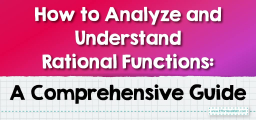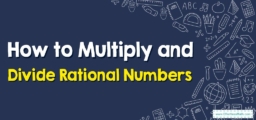How to Categorize Rational Numbers
A rational number is a quantity that can be delineated as a fraction, with the numerator and denominator being integers. The denominator, however, cannot be zero, as the mathematical principles preclude the division operation by zero.

A Step-by-step Guide to Categorize Rational Numbers
Here is a step-by-step guide to categorizing rational numbers:
Step 1: Comprehension of Rational Numbers
The rudimentary step to categorize rational numbers involves an unambiguous understanding of what rational numbers are. Essentially, a rational number is any number that can be expressed as a fraction where both the numerator and the denominator are integers (with the condition that the denominator is not zero, for the very notion of division by zero stands as an undefinable operation within our mathematical system).
Step 2: Identification of Numerator and Denominator
The second phase in our numerical expedition involves identifying the numerator (the number on top of the fraction) and the denominator (the number at the bottom). This partition is pivotal for the subsequent categorization process.
Step 3: Determining the Positive and Negative Rational Numbers
Once you’ve dissected the fraction into numerator and denominator, the third step involves determining whether the rational number is positive or negative. A rational number is considered positive when both the numerator and the denominator are either positive or negative. On the contrary, a rational number is deemed negative if either the numerator or the denominator (but not both) is negative.
Step 4: Recognition of Unit Fractions
Next, we dive into the domain of unit fractions – a special category within the realm of rational numbers. A unit fraction is one where the numerator is always one. By identifying these, you are differentiating a certain subset within rational numbers that possesses unique mathematical properties.
Step 5: Ascertain Rational Numbers as Decimals
Following the identification of unit fractions, our fifth step is to transcribe rational numbers into decimal form. This facilitates an alternate perspective on the classification of rational numbers. A rational number can be a terminating decimal (where the decimal form ends, e.g., \(0.25\)), or a repeating decimal (where a digit or a set of digits repeats indefinitely, e.g., \(0.333\)…).
Step 6: Identification of Whole Numbers and Integers
Our subsequent step encompasses identifying rational numbers that are also whole numbers (non-negative integers, e.g., \(0, 1, 2, 3,\) …) and integers (both positive and negative whole numbers including zero, e.g., …, \(-2, -1, 0, 1, 2,\) …). These constitute subsets of rational numbers and further refine our categorization.
Step 7: Fraction Simplification
The penultimate step in our rational number categorization journey requires you to simplify the fraction if possible. This is done by identifying common factors in both the numerator and the denominator, and then dividing both by the common factor until no more factors exist.
Step 8: Categorizing by Magnitude
The final stage of our categorization process involves grouping rational numbers by their magnitude or absolute value, which is the numerical value without regard to its sign. This way, you can further categorize rational numbers into groups such as less than one, equal to one, and greater than one.
Remember that categorization can be a very subjective process and it depends on the context and specific need. The steps provided are a guide and can be modified to meet your requirements.
You can also classify rational numbers visually using a Venn diagram, which we guide you step by step in the following section:
Step 1: Creation of a Basic Venn Diagram
A Venn diagram is essentially a graphical representation employed for the classification of numbers. This tool is instrumental in visually organizing information, facilitating better comprehension.
Step 2: Positive and Negative Rational Numbers
We then embark on our first primary segregation, bifurcating the rational numbers into two distinct domains: positive and negative. Positive rational numbers have the numerator and denominator of the same sign (either both positive or both negative), whereas negative rational numbers have the numerator and denominator of opposing signs (one positive and one negative). This categorization creates two non-intersecting circles within the rational numbers circle in your Venn diagram.
Step 3: Unraveling Unit Fractions
Subsequent to the division based on the sign, we explore the world of unit fractions. These are characterized by a numerator of \(‘1’\) and occupy their own unique sphere within the larger circle of rational numbers. In your Venn diagram, draw a circle for unit fractions within the positive rational numbers circle.
Step 4: Dissecting Rational Numbers into Decimals
The ensuing step in our rational number categorization odyssey involves representing them in decimal form. This perspective allows us to distinguish between terminating decimals (those that end after a certain number of decimal places) and repeating decimals (those that display an infinite repetition of a digit or series of digits). In your diagram, introduce two circles within both the positive and negative rational numbers circles, representing terminating and repeating decimals.
Step 5: Subsets: Whole Numbers and Integers
As we delve further into the categorical landscape, it is important to note that whole numbers (non-negative integers, e.g., \(0, 1, 2, 3,\) …) and integers (all positive and negative whole numbers including zero, e.g., …, \(-2, -1, 0, 1, 2,\) …) are subsets of rational numbers. Represent these subsets in your Venn diagram as circles within the positive rational numbers circle.
Step 6: Fraction Simplification
The ultimate step before final categorization involves simplifying the fractions where feasible. This process, entailing the identification and elimination of common factors from the numerator and the denominator, aids in achieving a clearer understanding of the rational numbers in question.
Step 7: Categorization Based on Magnitude
The grand finale of this categorization saga involves classifying rational numbers based on their magnitude, irrespective of their sign. You can further delineate rational numbers into those less than one, equal to one, and greater than one. Indicate these categories with different shading, hatching, or coloring within your diagram circles.
Always bear in mind that a Venn diagram serves as a visual aid, and its design and structure can be tailored to meet your specific requirements. It offers a concrete representation of complex mathematical classifications, fostering a more nuanced understanding of the subject.
Related to This Article
More math articles
- 7th Grade NYSE Math FREE Sample Practice Questions
- 10 Most Common 3rd Grade MCAS Math Questions
- The Ultimate ISEE Lower-Level Math Course (+FREE Worksheets & Tests)
- How to find Reference Angles from the Calculator
- How to Solve and Graph One-Step Inequalities with Rational Numbers?
- FREE CBEST Math Practice Test
- How to Decipher Limits and Function Values
- Average Value of a Curve
- How Is the SHSAT Test Scored?
- The Best Standing Desks for Online Teachers


























What people say about "How to Categorize Rational Numbers - Effortless Math: We Help Students Learn to LOVE Mathematics"?
No one replied yet.